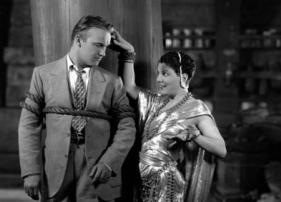Directed by Clarence Brown
Universal Pictures. Screenwriter: Melville Brown. Cinematographer: Milton Moore. Editor: Ray Curtiss. With: Louise Dresser, Jack Pickford, Constance Bennett, Gustav von Seyffertitz, George Nichols. 35mm, tinted, approx. 83 min.
Based on the short story by Rex Beach, the plot of The Goose Woman would have resonated with audiences of the mid-1920s by dramatizing a key component of the notorious 1922 Hall-Mills murder case—namely, a witness nicknamed “the Pig Woman” who gave unreliable testimony during the investigation in an attempt to solicit media attention.
Directed by Clarence Brown, the movie depicts the tale of Mary Holmes, a former prima donna who tragically lost her singing voice while giving birth to an illegitimate son, Gerald. Unable to move beyond this moment of great misfortune, she has descended into a life of crushing poverty and alcoholism, and bitterly blames her only child for the loss of her true love: celebrity. When a murder is committed next door to her derelict ranch, Mary hatches a plan to generate publicity for herself in the local press, unintentionally snaring Gerald as the prime suspect in the case. Fatefully, she is confronted with a decision that will determine her son’s destiny—and ultimately, her own.
Brown’s signature use of symbolism is clearly evident throughout the film (most notably in an early scene where Gerald accidentally breaks his mother’s only recording of her famed singing voice) and displays a deft hand guiding the moments of comedy that periodically relieve the story’s dramatic tension. Jack Pickford plays the role of Gerald with a reserved and nuanced performance, while Constance Bennett is impressive as Gerald’s fiancée Hazel, displaying some early signs of the innate screen charisma that would make her a star in the 1930s. But it is Louise Dresser who commands the picture with her portrayal of Mary and her astonishing transformation from disheveled harridan into a woman redeemed by the power of love.
Ultimately, critics and audiences alike favorably received the film, and Brown would again team with Dresser in his next film (the Rudolph Valentino hit The Eagle) before achieving greater fame at MGM directing the likes of Joan Crawford and Greta Garbo. The Goose Woman would be remade in 1933 as The Past of Mary Holmes featuring Helen McKellar and Jean Arthur.
Steven K. Hill
Preserved from 16mm diacetate prints. Laboratory services by The Stanford Theatre Foundation. Special thanks to Kevin Brownlow.






 Mobile Navigation
Mobile Navigation



